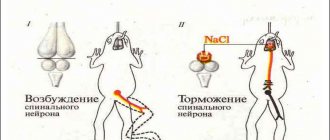Life is not only about eating food, chasing fashion brands and making money for it all. Life is, first of all, the formation and development of personality, the revelation of the essential characteristics and potential of a person. In psychology, this process is often called self-actualization, that is, the acquisition of one’s own “I”, the realization of all one’s resources: talents, abilities, capabilities.
The essence of self-actualization. K. Rogers' theory
The concept of “self-actualization” is fundamental in humanistic psychology - one of the leading areas of modern psychological science. It was first used by one of the founders of this trend, the American psychologist K. Rogers.
From his point of view, every person from birth has a need for self-actualization, and it is the driving force of all personal development. Society can help or hinder the realization of innate potential, but does not determine it.
All people have natural abilities and capabilities, and the main goal of any person is their maximum manifestation. This is self-actualization, which in psychology is considered as the full disclosure of the individual’s potential and the inclusion of all his abilities and talents in active work. Only in this case can a person feel like a full-fledged and harmonious person, this is what he should strive for.
The process of self-actualization has no age limit and lasts a lifetime, since there is no limit to perfection. From the point of view of K. Rogers, this is not only constant mental growth, but also the development of personal potential, when with each new step more and more opportunities for self-actualization are revealed to a person. Therefore, in psychology it is customary to talk about a self-actualizing personality, emphasizing that this is not a completed stage, but constant self-development.
A person gradually develops as a gifted, harmonious personality, useful not only for himself, but also for society. And he does not wait for society to make any strict demands on him or offer areas for the realization of his abilities. In the process of self-actualization, the individual has internal motives and incentives. He masters new types of activities, acquires new knowledge and skills, and is actively involved in professional and social life, because this is his nature. A self-actualizing person lives a very rich and interesting life, as she has many hobbies, plans, projects, ideas, and friends.
If self-actualization is the basic need of any person, then why don’t the mass of people strive for it? Another one of the founders of humanistic psychology, A. Maslow, answers this question.
Space for healing life. Personal website of Elena Barymova
Maslow's pyramid of needs.
Maslow argued that the totality of human needs can be described in the form of a hierarchical structure, in which more “earthly” needs are located at the bottom, and more “spiritual” ones at the top. According to Maslow, a person cannot experience the needs of the upper level until he satisfies the needs of the previous one. Here is this hierarchy: The need for the disclosure of internal potential, the need for aesthetics, the cognitive need - Maslow called this self-actualization The need for esteem The need for affection, love and belonging to a social group The need for security Physiological needs (food, sleep, thirst, etc. )
Accordingly, if we do not satisfy the need for nutrition, then for the sake of this need we will sacrifice not only aesthetic experiences, not only will we devalue the importance of maintaining our reputation, but we will often be ready to sacrifice even our own safety.
Criticism
This model has been criticized a lot and is being criticized mainly for the fact that it is not very universal. Of course, you don’t need to look long for examples confirming that this model makes sense, but you can also find many examples that do not fit into this model. Many artists, writers and poets wrote some of the most striking works in the most critical moments of their lives - in conditions of persecution, in repression, so is it possible to say that the unsatisfied need for security always “kills” the need for aesthetics and the disclosure of inner potential - a big question.
In the history of the church one can find many examples when people achieved holiness despite persecution, and many also deliberately put themselves in difficult conditions and limited themselves in the most basic needs, but this did not prevent them from revealing their inner potential. Moreover, the characteristics of their personality are very consistent with Maslow's description of a personality that has reached the peak of its development.
Why can this model be useful to us?
In general, there are questions about this model, but it also has its own truth. In addition to the fact that this model can help us make a structural assessment of how certain needs are met and move towards realizing our potential, I have also seen very practical applications of this pyramid. It is sometimes referred to when justifying the reluctance to read books, improve one’s qualifications, or when trying to negotiate more favorable terms of cooperation)
Signs of a self-actualizing personality according to Maslow.
1. More effective perception of reality.
The perception of the world is correct and impartial. The ability to see reality as it is, and not as one would like to see it. Less emotionality and greater objectivity do not allow hopes and fears to interfere, due to this a person communicates better, tolerates difficult situations better, and assesses the situation better. This helps not to be afraid of problems that do not have clear solutions.
2. Acceptance of yourself and others.
Self-actualizing people can accept themselves and others as they are. They are not overly critical of their shortcomings and weaknesses. They are not burdened by excessive feelings of guilt, shame and anxiety. These people do not have an overwhelming need to teach, inform or control. They can tolerate the weaknesses of others and are not afraid of their strength.
3. Spontaneity, simplicity and naturalness.
The behavior of self-actualizing people is marked by spontaneity and simplicity, the absence of artificiality or the desire to produce an effect. But this does not mean that they constantly behave contrary to traditions. They can adapt so as not to spoil relationships with other people.
4. Goal centeredness.
Maslow believed that all the individuals he examined, without exception, were committed to some task, duty, calling, or favorite work that they considered important. That is, they are not ego-centered, but rather focused on problems that are higher than their immediate needs, problems that they consider to be their life mission. In this sense, they live to work rather than work to live; work is subjectively experienced by them as their defining characteristic.
5. Independence: need for privacy.
Maslow writes that self-actualizing people not only tolerate, but even need, solitude.
6. Autonomy: independence from culture and environment.
Self-actualizing people are free in their actions, independent of the physical and social environment. This autonomy allows them to rely on their own potential and internal sources of growth and development. For example, a truly self-actualizing college student does not need the “right” academic atmosphere on campus. He can study anywhere. In this sense, it is a “self-sufficient” organism.
7. Freshness of perception.
Self-actualizing people have the ability to appreciate even the most ordinary events in life, while experiencing novelty, awe, pleasure and even ecstasy. For example, the hundredth rainbow is as beautiful and majestic as the first; a walk in the forest is never boring; The sight of a child playing lifts your spirits. Unlike those who take happiness for granted, self-actualizing people value good fortune, health, friends, and freedom. They rarely complain about a boring, uninteresting life.
8. Peak or mystical experiences.
While studying the process of self-actualization, Maslow came to an unexpected discovery: many of his subjects had what he called peak experiences. These are moments of great excitement or high tension, as well as moments of relaxation, peace, bliss and tranquility. They represent ecstatic states that are experienced in the culminating moments of love and intimacy, in impulses of creativity, insight, discovery and merging with nature.
9. Genuine interest in others.
Even when self-actualizing people are worried and sad, they still have a sincere desire to help others. This desire is expressed by feelings of compassion, sympathy and love for all humanity.
10. Deep interpersonal relationships.
Self-actualizing people strive for deeper and closer personal relationships than “ordinary” people.
11. Democratic character.
Self-actualizing individuals, according to Maslow, are the most “democratic” people. They have no prejudices and therefore respect other people, no matter what class, race, religion, gender they belong to, what their age, profession and other indicators of status are. Moreover, they readily learn from others without exhibiting superiority or authoritarian tendencies. A self-actualizing musician, for example, is full of respect for a skilled mechanic because he has knowledge and skills that the musician does not have.
At the same time, Maslow discovered that self-actualizing people do not consider everyone equal without exception: “These individuals, being themselves an elite, choose an elite as their friends, but this is an elite of character, ability and talent, and not of birth, race, blood, name, family, age, youth, fame or power.”
12. Philosophical sense of humor.
Another notable characteristic of self-actualizing people is their clear preference for philosophical, benevolent humor. While the average person may enjoy jokes that make fun of someone's inferiority, humiliation or obscenity, the self-actualizing person is more attracted to humor that ridicules the stupidity of humanity in general.
13. Creativity.
Maslow discovered that all self-actualizing people, without exception, have the ability to be creative. However, the creative potential of his subjects did not manifest itself in the same way as outstanding talents in poetry, art, music or science. Maslow spoke rather about the same natural and spontaneous creativity that is inherent in unspoiled children. It is creativity that is present in everyday life as a natural way of expressing an observant, perceptive personality. For example, speaking about his mother-in-law, whom he considered self-actualizing, Maslow emphasized precisely this fact. He said that although his mother-in-law did not have the talents of a writer or an actor, she was highly creative in preparing soup. Maslow observed that first-rate soup always contains more creativity than second-rate poetry!
14. Resistance to cultivation.
And finally, self-actualizing people are in harmony with their culture, while at the same time maintaining a certain internal independence from it. They have autonomy and self-confidence, and therefore their thinking and behavior are not subject to social and cultural influence. This resistance to enculturation does not mean that self-actualizing people are unconventional or antisocial. In this case, we are talking more about the fact that following the norms is not a rule they follow, but their own internal choice, and if at some point they do not agree with the rules, they will not necessarily fight these rules at any cost, but they can also fight when it makes sense.
***************************************************************************
Sign up for individual sessions and consultations
Hierarchy of needs, or the path to self-actualization
The need for self-actualization, although the highest, is not the only human need. From the point of view of A. Maslow, the question of its satisfaction arises only when and if the needs of the lower levels are satisfied. This psychologist formulated the principle of a hierarchy or pyramid of needs, which serve as motivation for personal development. There are a total of five levels in this pyramid:
- Physiological level. It contains all natural, biological needs: food, water, warmth, biological partner, health, etc.).
- The level of security is not only the need for the absence of a threat to life and health, but also the need for peace of mind, confidence in the future, a well-paid job or a comfortable home, peace and prosperity.
- Social level. It contains the needs for a comfortable social environment, friends, loved ones, family.
- The level of self-esteem is the need for self-esteem, self-acceptance and pride in the results of one’s activities.
- Level of self-actualization. At this level, according to A. Maslow, there are needs for creativity and socially approved activities, for personal harmony and beauty, for the fullest possible realization of one’s own “I”.
If you build a hierarchy of needs in the form of a pyramid, then self-actualization will be at the very top, and it is based on all lower levels. This is very important, since a person thinks about higher-level needs only if the lower ones are satisfied. From a hungry person who does not have proper housing, one should not expect not only harmonious development, but also self-respect. And he begins to think about family no earlier than he has dealt with the first two levels.
But this does not negate the importance of the highest level to which one must strive. Moreover, A. Maslow only called a person who has reached the level of self-actualization a psychologically healthy person.
Maslow's pyramid
According to Maslow, all human needs are innate. They are located on five levels of the pyramid. Basic needs are located on the first level. After satisfying the underlying needs, a person fulfills the higher ones.
Levels of Maslow's pyramid of needs:
- physiological needs;
- safety;
- Love;
- respect;
- self-actualization.
Physiological needs include hunger, thirst, and sleep. Security is understood as the need for order, freedom from fear and anxiety, and stability. Love – for wife, husband, children, friends. Respect – by strangers and by the person himself.
Subsequently, Maslow added two more needs to the pyramid: cognitive abilities (this includes skill, understanding, knowledge) and aesthetics (harmony, beauty). He placed them under the need for self-realization.
Self-actualization as a process
And yet it is not clear why there are so many seemingly quite prosperous, “settled” people around, who do not even think about self-actualization, but simply go with the flow? Are they doing so well? Or, perhaps, not too well, and a feeling of dissatisfaction gnaws at them, but they do not know and do not understand what and how to change in life. How to embark on the path of self-actualization, stop waiting for “tomorrow” (or Monday), and start living in this “tomorrow”?
Humanistic psychology has answers to these questions. A. Maslow describes a number of possible methods or conditions for self-actualization:
- Experiencing and living everything that happens to you, without distancing yourself from what is happening and without burying your head in the sand. It must be remembered that self-actualization presupposes the fullness of life in all its manifestations.
- Understand life as a constant choice of path options, actions, relationships with people. Do not shy away from the need for choice and appreciate the fact that its opportunity is available only to a free person.
- Self-actualization is not just freedom of choice, but also responsibility for it, for everything that happens to you and your environment. Understand that responsibility is not a burden, but a benefit and social advantage of an adult free person.
- Responsibility to oneself and society is combined with independence - judgments, thoughts, opinions, actions. An independent person is free, and self-actualization is impossible without freedom.
- Trust in yourself, your experience, opinion, position.
- Self-actualization is a creative process. And enjoying creativity, experiencing the ecstasy of inspiration is an important condition for it.
- Awareness of all your problems, including mental and physical, and the ability to find the strength to overcome them, without hiding behind the barrier of psychological defense.
Self-actualization may not be easy at all, but this process occurs in different ways - for some it seems natural and easy, as if a person is moving forward and upward without experiencing any problems. And for some, self-actualization is associated with serious intrapersonal problems and social conflicts.
Types of self-actualization
Self-actualization is not only complex, but also a very individual process. We can say: as many people as there are, so many options, because this is the revelation of personal potential. However, there are also common points in the process of self-actualization, and they allow us to distinguish several of its types.
Superficial and deep
The superficial one is more common and involves the actualization of a variety of personality qualities without their critical analysis and evaluation. This is free self-expression, in which not always the best and socially acceptable “talents” of an individual can be realized. After all, every person is a complex alloy of good and bad, positive and negative properties. Here, superficial self-actualization does not concern the understanding of their social significance. In simple words: what has developed has developed.
Deep, on the contrary, is the result of introspection and assessment of one’s potential not only in terms of level, but also in terms of social significance. Deep self-actualization is always growth, progressive, progressive development with the identification and disclosure of all the best in a person, those qualities that ensure the efficiency and productivity of his development and interaction with society.
Harmonious and problematic
It is good if the process of socialization is not only actively carried out by the individual himself, but also supported by society. And it’s absolutely wonderful if a person, even in his early youth, decided on the sphere of realization of his talents and abilities. He clearly knows what he wants and goes straight towards his goal, rejoicing in every success, and perceiving failures as a useful experience.
But unfortunately, such harmonious self-actualization does not happen to everyone. Often a person rushes about in search of himself, a way to realize his personal potential. And he fails because he cannot find the right path and is disappointed in his capabilities and in his benefit to society. All this can become a source of serious mental problems, and such a restless personality is sometimes at odds with society. The creativity of this person is often not accepted by society, and the hope for success is not justified.
Perhaps the individual has chosen the wrong path, the wrong field of activity, or his psyche is not able to cope with the load he has given. You cannot go to success by jumping three steps - this is the easiest way to stumble and fall.
Active and careful
These two types have been described by various leaders of humanistic psychology. Active was described and supported by A. Maslow, and K. Roger believed that the most acceptable is cautious.
What is their difference? In active or energetic self-actualization, a person moves forward, rapidly overcoming difficulties. He wants to achieve his potential and success as quickly as possible. Russians say about such people that everything is going wrong in their hands or that their soles are on fire. And indeed, this person is capable of not only burning, but also igniting others with his energy and enthusiasm.
But K. Roger believed that gradual, thoughtful work on oneself, the accumulation of internal potential and resources for a leap forward are much more useful for the individual. Such a person may move more slowly, but he makes fewer mistakes, and as a result, on the path to success he often outstrips those who are too ardent and energetic.
Probably, if the goal was to create a classification of types of self-actualization, then many more could be identified. But no one has set this goal in psychology yet.
Definition
Abraham Maslow coined the concept of “self-actualization.” This is an American psychologist, the creator of the humanistic direction in psychology, the author of the book “Motivation and Personality.”
He gave different definitions of self-actualization:
- In early works, the term was defined as a person's desire to move upward. This is the continuous realization of one's own potential, the fulfillment of one's destiny. He put into this concept a tireless desire to achieve harmony of soul and body. In this context, self-actualization is a process of growth.
- In later trainings the term is described as a result of growth. Maslow says that self-actualization is the full use of one’s own capabilities and talents, personal health.
Personalization is part of self-realization. Defined as the need to be an individual.
What kind of self-actualizing personality is she?
To summarize, let's figure out who can be called a self-actualizing person? Well, perhaps we’ll try on this image. You are definitely such a person if you:
- open to the world and positive towards it;
- accept reality and yourself as part of this reality, without opposing your own personality to others, without awakening in yourself anger, hatred, envy, rejection;
- you accept the people around you as they are, do not try to fit them to your own “measures”; you respect any person, regardless of his religion, nationality, social status and you know for sure that the beauty of the world is in its diversity;
- are passionate about your work, which is not a burden to you, but a joy; you consciously made your choice and do the work because you like it, and not just for the money;
- clearly distinguish between good and evil, bad and good, and do not hide behind the excuse that the end justifies the means;
- you have a good sense of humor and a desire to smile at people around you and at life;
- you accept not only the joys of the world, but also its problems and do not hide from them, but solve them in accordance with your principles.
As you can see, there is nothing unusual or supernatural in the qualities of a self-actualizing personality, and this path is within the power of everyone.









